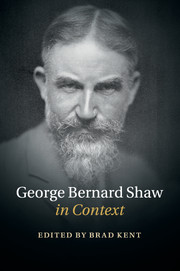Book contents
- Frontmatter
- Dedication
- Contents
- List of illustrations
- Notes on contributors
- Preface
- Acknowledgements
- A Chronology of Shaw's Works
- List of abbreviations
- PART I PEOPLE AND PLACES
- 1 Dublin
- 2 The Fabian Society
- 3 Germany and Austria
- 4 London
- 5 Oscar Wilde
- 6 W. B. Yeats
- PART II THEATRE
- PART III WRITING AND THE ARTS
- PART IV POLITICS
- PART V CULTURE AND SOCIETY
- PART VI RECEPTION AND AFTERLIFE
- Further reading
- Index
- References
6 - W. B. Yeats
from PART I - PEOPLE AND PLACES
Published online by Cambridge University Press: 05 October 2015
- Frontmatter
- Dedication
- Contents
- List of illustrations
- Notes on contributors
- Preface
- Acknowledgements
- A Chronology of Shaw's Works
- List of abbreviations
- PART I PEOPLE AND PLACES
- 1 Dublin
- 2 The Fabian Society
- 3 Germany and Austria
- 4 London
- 5 Oscar Wilde
- 6 W. B. Yeats
- PART II THEATRE
- PART III WRITING AND THE ARTS
- PART IV POLITICS
- PART V CULTURE AND SOCIETY
- PART VI RECEPTION AND AFTERLIFE
- Further reading
- Index
- References
Summary
They met through William Morris at Kelmscott House. ‘An Irishman named Yeats talked about Socialism a good deal’, noted Shaw in his diary for 12 February 1888 (Diaries I: 348). Yeats for his part was a little less laconic in a long gossipy letter to his friend Katherine Tynan of the same date: ‘Last night at Morrises I met Bernard Shaw who is certainly very witty. But like most people who have wit rather than humour, his mind is maybe somewhat wanting in depth – However his stories are good they say’. Morris was a hero for both of them, though for quite different reasons. Yeats's interest in socialism was very brief; for him it was Morris's Pre-Raphaelite aestheticism that was so attractive. For Shaw, Morris was above all a prophet and a revolutionary, his poetry and his work in the decorative arts only the means to a greater end of radical social change. Shaw and Yeats's meeting ground in the Morris circle was symptomatic of their long, if intermittent relationship, a Venn diagram of overlapping interests flanked by distinctively divergent attitudes. It can be seen in their rivalry over the actress Florence Farr, with whom they both had affairs. It was a feature of Shaw's involvement with the Abbey Theatre, whether in relation to the Shaw play the theatre did premiere (The Shewing-up of Blanco Posnet) or those it did not (John Bull's Other Island, O'Flaherty, V.C.). In business and professional matters, where Yeats often depended on the older and more experienced Shaw for guidance, it was always with a degree of doubt and distrust; they had very different managerial styles. They were able to work together for common causes, but their opposed ways of seeing the world meant that they could never be close friends or collaborators.
Shaw and Yeats were both part of the Morris circle, but it was their common interest in Florence Farr that first brought them into frequent contact. Farr, an extremely good-looking married woman, estranged from her husband and sexually liberated – she ‘already had a sort of Leporello list of a dozen adventures’ by the time Shaw met her, he claimed – was a draw for both the inhibited and frustrated Irishmen. By 1890 Shaw was her lover, but Yeats was also a close friend and was to have a brief affair with her much later.
- Type
- Chapter
- Information
- George Bernard Shaw in Context , pp. 44 - 50Publisher: Cambridge University PressPrint publication year: 2015



